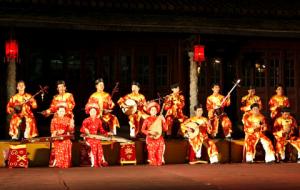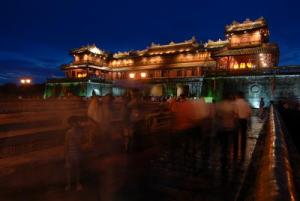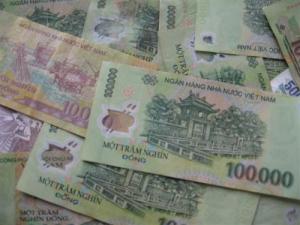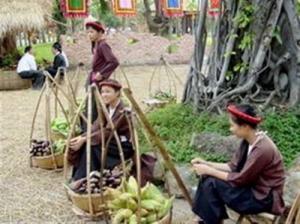Vietnam’s five “cultural specialties” to go to the world

From May 27 to June 3, 2011, Vietnam will introduce its five world cultural heritages at the World Intangible Cultural Heritage Exhibition in China.
The five Vietnamese cultural heritages include: Hue royal court music (nha nhac), Central Higlands gong culture, Ca tru (ceremonial songs), Quan ho (Bac Ninh love duets) and Giong Festival.
According to the Ministry of Culture, Sports and Tourism, the Vietnam Culture and Art Exhibition Center and the International Cooperation Department are assigned to prepare for the exhibition, which is expected as a chance to introduce Vietnam’s culture to the world.
1. Nha nhac was performed at annual ceremonies, including anniversaries and religious holidays, as well as special events such as coronations, funerals or official receptions, by highly trained and skilled court musicians. Along with the musicians, a number of intricate court dances also exist. Both musicians and dancers wore elaborately designed costumes during their performances.
Instruments commonly used for nhã nhạc include: kèn bầu (conical oboe), đàn tỳ bà (pear-shaped lute with four strings), đàn nguyệt (moon-shaped two-string lute), đàn tam (fretless lute with snakeskin-covered body and three strings), đàn nhị (two-stringed vertical fiddle), sáo (also called sáo trúc; a bamboo transverse flute), trống (drum played with sticks), and other percussion instruments.
It is believed that Nha nhac did not truly reach the pinnacle of its development until the Nguyễn Dynasty, when it was synthesized. The Nguyen emperors declared it as the official court music, and it became an essential part of the extensive rituals of the royal palace.
Nha nhac was recognized in 2005 by UNESCO as a Masterpiece of the Oral and Intangible Heritage of Humanity. Extensive efforts have gone underway to preserve this truly unique and highly developed art.
2. Space of Central Highlands gong culture was recognized by UNESCO as a Masterpiece of the Intangible Heritage of Humanity on November 25, 2005. The space of Gong culture spreads in the Central Highlands provinces of Kon Tum, Gia Lai, Dak Lak, Dak Nong, and Lam Dong.
The cultural space of the gongs in the central highlands of Vietnam covers several provinces and seventeen Austro-Asian and Austronesian ethno-linguistic communities.
Closely linked to daily life and the cycle of the seasons, their belief systems form a mystical world where the gongs produce a privileged language between men, divinities and the supernatural world. Behind every gong hides a god or goddess who is more powerful when the gong is older.
Every family possesses at least one gong, which indicates the family’s wealth, authority and prestige, and also ensures its protection. While a range of brass instruments is used in the various ceremonies, the gong alone is present in all the rituals of community life and is the main ceremonial instrument.
The manner in which the gongs of Vietnam are played varies according to the village. Each instrumentalist carries a different gong measuring between 25 and 80 cm in diameter. From three to twelve gongs are played by the village ensembles, which are made up of men or women.
Different arrangements and rhythms are adapted to the context of the ceremony; for example, the ritual sacrifices of the bullocks, the blessing of the rice or mourning rites. The gongs of this region are bought into neighboring countries, and then tuned to the desired tone for their own use.
Economic and social transformations have drastically affected the traditional way of life of these communities and no longer provide the original context for the Gong culture. Transmission of this way of life, knowledge and know-how was severely disrupted during the decades of war during the last century.
Today, this phenomenon is aggravated by the disappearance of old craftsmen and the young person’s growing interest in Western culture. Stripped of their sacred significance, the gongs are sometimes sold for recycling or exchanged for other products.
3. Ca tru was inscribed on the list of Intangible Cultural Heritage in need of Urgent Safeguarding in 2009.
Ca tru is a complex form of sung poetry found in the north of Vietnam, using lyrics written in traditional Vietnamese poetic forms.
Ca tru groups comprise three performers: a female singer who uses breathing techniques and vibrato to create unique ornamented sounds, while playing the clappers or striking a wooden box, and two instrumentalists who produce the deep tone of a three-stringed lute and the strong sounds of a praise drum.
Some Ca tru performances also include dance. The varied forms of Ca tru fulfill different social purposes, including worship singing, singing for entertainment, singing in royal palaces and competitive singing. Ca tru has fifty-six different musical forms or melodies, each of which is called the cach. Folk artists transmit the music and poems that comprise Ca tru pieces by oral and technical transmission, formerly, within their family line, but now to any who wish to learn.
Ongoing wars and insufficient awareness caused Ca tru to fall into disuse during the twentieth century. Although the artists have made great efforts to transmit the old repertoire to younger generations, Ca tru is still under threat of being lost due to the diminishing number and age of practitioners.
4. Quan ho is recognised as the Intangible Cultural Heritage by the UNESCO in 2009.
Quan ho singing is a Vietnamese folk music style characterized both by its antiphonal nature, with alternating groups of female and male singers issuing musical challenges and responses, and by the fact that most of the songs in the repertoire deal with topics of love and sentimentality as experienced by young adults.
The Quan ho style originated in what is now Bac Ninh Province and was first recorded in the 13th century, and has traditionally been associated with the spring festivals that follow the celebration of Tet (the Vietnamese New Year).
Historically, the singing began on the evening before the festival, but today it is much more common for the singing to occur on the main day of the festival.
In general, an initial "challenge phrase" (cau ra) from the known body of songs is sung by a pair of female singers, following which a pair of male singers will respond by selecting and singing a "matching phrase" (cau doi), which must repeat the melody of the challenge phrase. Once they are finished, the order is reversed, and the men will issue their own challenge phrase with a different melody.
While in the past the singing was unaccompanied, it is common today for the singers to be accompanied by instruments, whether traditional Vietnamese instruments or modern ones such as electric keyboards.
There are a huge number of Quan ho melodies, with thousands of different songs having been recorded and written down in score form.
5. Giong Festival was listed on the UNESCO List of the Intangible Cultural Heritage in 2010.
Giong Festival is a traditional festival which is celebrated annually in many parts of Hanoi to honor the mythical hero, Saint Giong, who is credited with defending the country against foreign enemies.
Giong Festival is held April 6-12, of the lunar year in several venues around Hanoi and attracts thousands of tourists. The biggest Giong festival is at Phu Dong Village in Gia Lam District of Hanoi, where the hero, Emperor Phu Dong was born.
Legend tells…that Giong and the people of Van Lang (the old name of Vietnam) defeated the An invaders. After the victory, Giong rode his iron horse up to the sky. To show the gratitude to the hero of Giong Village who sacrificed his life to fight the invaders, Vietnamese people honor him as a saint. The procession starts at the Mother Temple to Thuong Temple, with the performance of a religious service at Kien So Pagoda.









